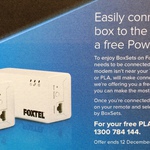Successfully ordered 2 pairs of these earlier today for my 2 Foxtel boxes. Operator kindly told me they're mine to keep, even if I decide to cancel my subscription. Took all of 2 minutes on the phone.
Will be using these as ethernet extensions for my desktop PCs I reckon. If you're not keen on wifi, these work perfectly well with Xbox, PS, or anything else that needs an ethernet or 'secure' wired connection.
Offer ends December 12th. Good luck :)






They will work on extension leads and powerboards to some extent.
However, the more connections and cable used, the throughput will be reduced.
Also note that surge protectors/filters can significantly impact throughput/signal strength as well as noise on the line from other devices. Particularly those with switching power supplies (nearly all electronics these days).
I found (if possible) that plugging both units into the same powerboard to confirm they are set up correctly initially was helpful.